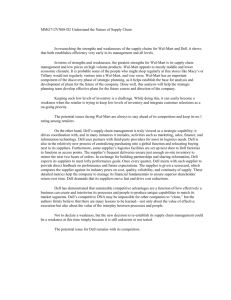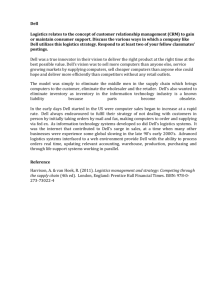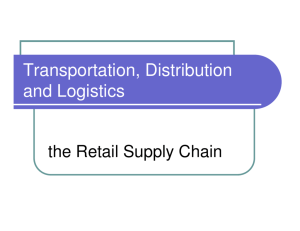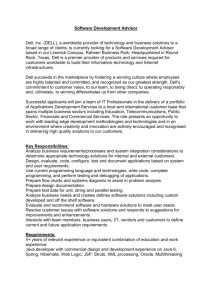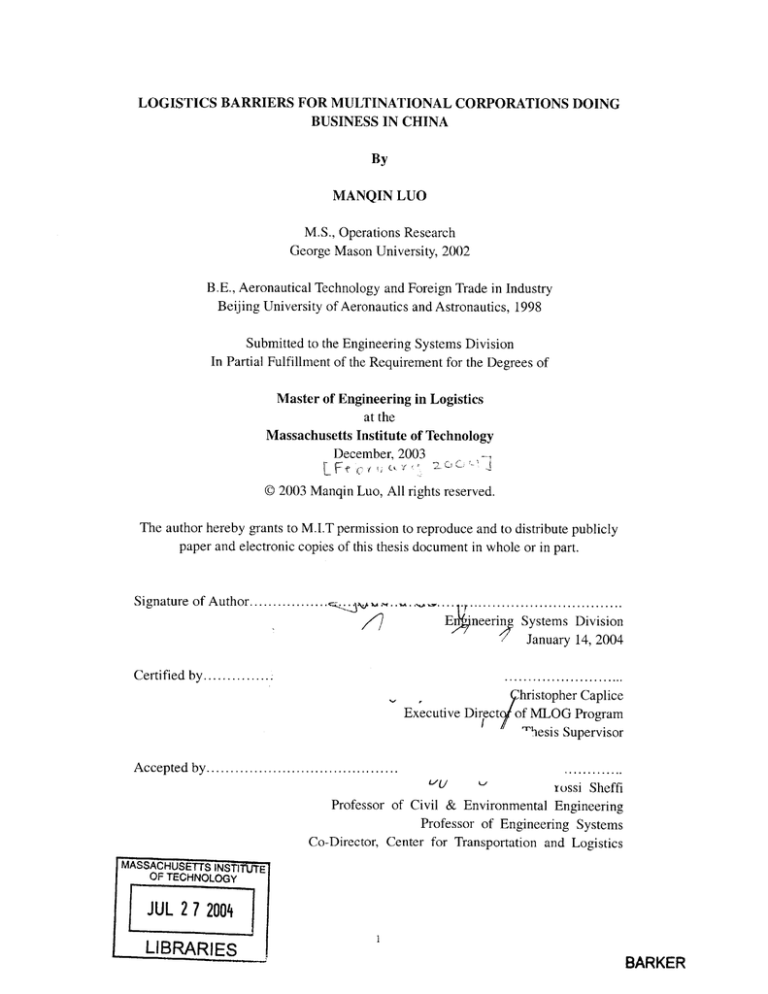
LOGISTICS BARRIERS FOR MULTINATIONAL CORPORATIONS DOING
BUSINESS IN CHINA
By
MANQIN LUO
M.S., Operations Research
George Mason University, 2002
B.E., Aeronautical Technology and Foreign Trade in Industry
Beijing University of Aeronautics and Astronautics, 1998
Submitted to the Engineering Systems Division
In Partial Fulfillment of the Requirement for the Degrees of
Master of Engineering in Logistics
at the
Massachusetts Institute of Technology
December, 2003
© 2003 Manqin Luo, All rights reserved.
The author hereby grants to M.I.T permission to reproduce and to distribute publicly
paper and electronic copies of this thesis document in whole or in part.
S ign ature o f A u tho r.................
E
.............................
..
-neerin Systems Division
January 14, 2004
C ertified by ........ .....
..........................
Executive Direct
A ccep ted by .....................................
..
hristopher Caplice
of MLOG Program
-esis Supervisor
............
LI'UI
xossi Sheffi
Professor of Civil & Environmental Engineering
Professor of Engineering Systems
Co-Director, Center for Transportation and Logistics
MASSACHUSETTS INSTI
OF TECHNOLOGY
E
JUL 2 7 2004
LIBRARIES
BARKER
2
Logistics Barriers for Multinational Corporations Doing Business in China
By
Manqin Luo
Submitted to MIT Engineering Systems Division
On December 5, 2003
In Partial Fulfillment of the Requirement for the Degrees of
Master of Engineering in Logistics
Abstract
With rapid economic growth, China attracts many multinational corporations (MNCs)
as a manufacturing center with both its cheap labor cost and a huge consumer market.
While doing business in China, most MNCs have faced logistical problems in
connection with the transportation of their materials and the flow of information. The
research objective of this paper is to describe the current state of Chinese logistics
service and identify the logistics barriers that foreign firms have encountered in China.
Dell and Wal-Mart are selected as case studies. The thesis analyzes their operating
strategies and solutions to various problems they encountered in China and makes
some recommendations.
Thesis Supervisor: Christopher Caplice
Title: Executive Director of MLOG Program
3
Acknowledgement
I would like to thank my thesis advisors, Chris Caplice for precious time and effort he
has devoted to assisting me in the completion of this thesis. I could not have asked for
better guidance than what he has given to me in the development of this thesis.
Beyond the completion of this piece of research, the more precious things that I
appreciate are the generous help from many faulty members in MLOG program
including Jim Masters, Yossi Sheffi in the past one and a half year, especially during
the difficult time.
I also want to express my appreciation to Ming Li, Edward Fan for sharing useful
information which is helpful to my thesis project, to Xiaoping Chen, Yi Cai,
Benjamin Zheng and Daguang Zhang for warm help during the time together.
Finally, thank you to my dear husband, Peng, for so much love and encouragement
and consistent support.
4
Table of Content
1. Introduction and Literature Review .....................................................................
1.1. Current State of Logistics Service in China ...............................................
1.2. Transportation Infrastructure ....................................................................
1.2.1.
1.2.2.
1.2.3.
1.2.4.
Road...............................................................................................
Water...............................................................................................
Rail System ....................................................................................
Air Express and Air Cargo ..............................................................
1.2.5. M ulti-M odal Transportation .........................................................
6
6
7
8
8
9
10
11
1.3. Warehousing ..........................................................................................
1.4. Sum m ary ................................................................................................
12
12
2. Logistics Barriers of M ultinational Corporations in China ................................
2.1. Profit Potential for Different Industries ...................................................
2.2. Logistics Barriers....................................................................................
2.3. Sum m ary ................................................................................................
14
14
17
19
3. Supply Chain Practice of Dell in China............................................................
21
3.1. Introduction ............................................................................................
3.2. Direct-Sales M odel .................................................................................
3.3. Dell's A dventure in China .......................................................................
3.4. Sum m ary ................................................................................................
4. Supply Chain Practice of Wal-M art in China....................................................
21
21
22
28
30
4.1. Introduction ............................................................................................
30
4.2. W al-M art in China .................................................................................
4.3. Sum m ary ................................................................................................
30
35
5. Conclusion and Key Points ...............................................................................
36
REFERENCES.....................................................................................................
41
5
1. Introduction and Literature Review
This Chapter describes the current state of Chinese logistics service management,
reviews literature covering some aspects of China's supply chain infrastructure and
analyzes the impact of its supply chain inefficiency.
1.1. Current State of Logistics Service in China
China's economy has been enjoying rapid growth over the last two decades.
China officially became a member of World Trade Organization (WTO) in November
2001. In recent years, China has become an increasingly important arena for
multinational corporations because of China's vast market potential and low labor
cost. Foreign direct investment and multinational corporations have brought new
manufacturing capacity to China and helped China become one of the world's major
workshops. According to Dr. Fu Yuning, President of China Merchants Group, in a
speech to the American Chamber of Commerce on July 9 2003, foreign direct
investment reached a record of US$52.7 billion in 2002 [1], making China the largest
recipient of foreign direct investment in the world, surpassing the Unite States. Within
its first year in the WTO, the Chinese GDP grew by 8% [2].
However, logistics services have become one of the most important bottlenecks to
the rapid economic developments in China. There is a big gap between their
international supply chain requirements and current services provided by local
logistics companies. Due to the rapid localization of production, multinational
6
corporations have a higher level requirement of logistics services. Facing the
country's
external environment and the trend of increasing competition from
international competitors, logistics service in China is still very weak and inefficient.
China's logistics costs - including both corporate outsourcing and in-house logistics
expenditures - were approximately US$245 billion, 20% of its GDP in 2002. The
logistics costs in China is about 40-50% higher than that in developed countries [1].
The logistics market in China is also very fragmented. No logistics company has
more than 2% share of the China market as of 2002 [3]. Many of the logistics
companies are only traditional transportation and warehousing companies. They just
provide simple service such as transportation and warehousing and are not able to
offer value-added services like information technology and inventory management.
Thus problems such as lack of expertise and technologies are very serious. With WTO
entry, foreign logistics giants such as United Parcel Services (UPS), Federal Express,
DHL Worldwide Express and American President Lines Co. Ltd. all came to find a
niche in China's logistics market. They constitute a big challenge to those local
logistics companies who have not yet become powerful.
1.2. Transportation Infrastructure
There are four transportation modes for multinational corporations in China: road,
water, railway and air. Since pipeline transportation is used mainly by state owned
companies, it is neglected here.
7
1.2.1. Road
Owing to its flexibility, trucking is the mode of choice for finished goods
producers in most mature economies. It is also the one of the most commonly used
transportation modes in China. Currently, highway transportation constitutes about
25%-30% of the market volume (ton-miles). China has been rapidly developing its
highway system in the past few years. It added 36,000km of highways and 3,152km
of expressways in 2001 alone. Investment in highways for 2001 was $37.66 billion. In
adherence to the government's "go west" policy on western expansion, Sichuan
province plans to have 4,600 km of expressways built by 2020 [4].
In China, the types of carriers available vary in different locations. In big cities
such as Beijing, Shanghai and Guangzhou, there are more private and foreign carriers
available to serve the larger population of foreign firms investing there. While in the
other less developed inland cites such as Qinghai and Lanzhou, the problem of a
shortage of carriers is very serious.
1.2.2. Water
Ocean Shipping
Ocean shipping has been one of the most open sectors in China for years. By the
end of June 2000, there were already nearly 80 wholly owned foreign shipping
companies and branches, plus 120 joint-venture shipping companies operating [5].
China has sixteen major shipping ports with a capacity of over 5 million tons per year,
combined for total country shipping capacity in excess of 1400 million tons. Many
8
ports are going through a significant upgrade [4]. With the development of the modern
logistics industry, the ports will increase the number of goods transition centers,
improve transportation and warehousing facilities to replace the traditional loading
and unloading practices.
River Shipping
Usually MNCs don't consider river shipping as an important transportation mode
now. But we expect that it will be used much more common soon. The reason is the
labor cost in the west is much cheaper than in the east coast. Thus Chinese
government has applied the "Go West" policy which plans to open up and develop its
western regions. More and more labor-intensive industries, such as manufacturing,
may start to move to the west. Since there are no existing railways that connect the
west with the east and it is time-consuming to construct new railways, we can expect
that factories will settle along the rivers active in shipping such as Yangtze and Pearl.
River shipping will become a prevalent transportation mode very soon.
1.2.3. Rail System
The rail system has been extensively used because of its relative low cost. It is
mainly used for transportation of bulk and raw materials. Now rail transportation
constitutes about 50% - 55% of the market volume (ton-miles) [4]. Rail transportation
becomes less competitive than before. The cost of rail transportation is only one third
of trucking in China. The main reason companies still prefer trucking than rail system
is that in China the railway containers are not compatible with those used by shipping
9
companies. If rail transportation is chosen, frequent unloading and reloading cargos
will cause higher handling costs and higher damage rates. The other reason is that
many small companies do not have the volumes that enable them to enjoy the
economy of scale of rail transportation.
1.2.4. Air Express and Air Cargo
Express Mail Service (EMS), which is under China Post, dominates 70% of the
domestic express market. The large market share is because of China Post's extensive
network and legislative protection. Joint ventures between foreign companies such as
UPS, DHL, TNT and FedEx and domestic companies have about 30% of the market
share. While on the international express market, EMS and joint ventures have about
50% of the international market share respectively [4].
Domestic Market
E EMS
U Joint Ventures
10
I
International Market
E EMS
50%
50%
U Joint Ventures
Figure-I Market Share of Air Express
1.2.5. Multi-Modal Transportation
Currently, very few companies have the capability to offer integrated multi-modal
transportation service in China. Sinotrans International Multi-modal Transportation
and a couple of foreign players (SempCorp Logistics and APL Logistics) are the
leaders in this field. They usually have strategic alliances with local players in
addition to their strong international presence and extensive network [8].
Infrastructure that connects the west to the east (e.g. highways and river ports
along the Yangtze River) will be developed or further improved in the next one to two
five-year plans [1]. When the projects are completed, more and more manufacturing
facilities will be moving to the west to take advantage of the lower labor cost.
Demand for multi-modal transportation will increase, as more companies will choose
rail and river shipping as the preferred mode for inland shipping with volume and
scale. Thus, we expect that the demand for multi-modal transportation will increase.
11
1.3. Warehousing
Warehousing in China cannot satisfy customers due to the poor infrastructure and
inadequate
information
systems.
Most of the
warehouses
in
China are
not
storied-shelf type. Currently, the dominant type of warehouse in China is still the
bungalow or open storage yards [6]. Storied-shelf warehouses constitute less than
10% of the warehouses and only 20% of the companies have more than 50% of their
warehouses of the storied-shelf type [6].
Figure-2 Storied - Shelf
High discrepancies in actual and recorded inventory data, high damage and
missing rates, and general lack of real-time product and order tracking and tracing is
the current situation of warehouse management in China. Manufacturers thus have no
other choice but to build their own facilities.
1.4. Summary
In conclusion, the infrastructure has been greatly improved in recent years. The
Chinese government have invested large sum of money to construct highways and
12
railroads. Quality highways, telecommunications, high-speed internet connectivity
and responsive local government have attracted many multinational corporations.
But compared with developed countries such as United States, China is still laggard
in some
aspects
such as insufficient
transportation
system
and
antiquated
warehousing. Due to these shortcomings, it is very difficult for companies to apply
standard approaches to supply chain management. Facing various problems such as a
fragmented distribution system and government bureaucracy, the Chinese logistics
system is very inefficient. The Chinese government is currently investing large sums
of money to upgrade China's logistics and transport infrastructure. The government
has listed a project named "establishing modern logistics service models and sample
companies" in its tenth five-year plan. The goal of the project is to set up 30 modern
logistics/distribution centers, while cultivating and developing about 10 larger-scale
logistics enterprises with a nationwide network [1].
After broadly introducing Chinese logistics service, we will discuss specific
logistics problems MNCs have met and their subsequent solutions.
13
2. Logistics Barriers of Multinational Corporations in China
This chapter identifies the logistics barriers that multinational corporations have
encountered in China and analyzes their impact on the development of those
companies.
2.1. Profit Potential for Different Industries
China's rich market potential and rapid economic development have attracted
more and more MNCs entering China to take advantage of the open door policy and
low labor cost. Almost all major MNCs have joined the competition in various
industries in China. With the trend of increasingly more severe competition, there are
higher operational risks and customers have higher expectation to logistics services
than ever before. The MNCs are facing both fantastic opportunities and tough
challenges. Some companies have taken up an advantageous position in China market
and made huge profits in China, while others have not created the success they
expected yet and even lost millions. For instance, the chain restaurant industry seems
the most lucrative in China. The CEO of Pizza Hut described the Chinese market as a
gold mine. A new Pizza Hut restaurant is being opened every two days. But, in
comparison, Wal-Mart has hardly made any profit after struggling for many years [10].
It proves multinational corporations in different industries have met barriers of
different levels in China.
14
Investment analysts such as Merrill Lynch say only a few of the foreign
companies in the Chinese market are making money. China's top 25 companies had an
average return of just over 3% last year. Even market leaders such as Coke and
Motorola have a return of about 5% -- far below what they make anywhere else in
Asia [10].
According to Merrill Lynch's monthly report on the profits of MNCs who are
manufacturing and selling in China, MNCs in different business sectors have different
potential to make profits. The result shows that industries in which at least some
multinationals are profitable are fast-moving consumer goods, heavy machinery and
equipment, automobiles, mobile-phone and computer hardware. Sectors marked by
widespread losses include retail and home appliances.
Merrill Lynch regards consumer goods as the most promising sector for
multinationals. Companies such as Colgate & Palmolive, Procter & Gamble and
Unilever all claimed profitability there.
Some heavy mechanical equipment companies are also enjoying quick growth
because almost all of the local governments and enterprises are upgrading the
infrastructure. For example, many Chinese airports plan to upgrade their airport
facilities in the next 5 years. The companies earning profits include General Electric,
Siemens and Caterpillar.
China's car market is booming. The sales volume of automobile companies is
increasing very quickly. However, the higher sale volume doesn't mean subsequent
higher profits because of the imminent pressure to lower the price. For instance, the
15
sales volume of Volkswagen in China increased by 42.8% in 2002 but the operations
profits only increased by 5.6% [10].
The competition of mobile phone market is more severe than in the 1990s. The
local manufacturers become more and more competitive with outstanding design,
savvy marketing and attractable pricing. Foreign giants such as Motorola and Nokia
used to dominate the market. The situation now has totally changed. The market share
of Motorola in China reduced from 40% in 1999 to 26% in 2002. The market share of
Nokia reduced from 32% to 18% in 2002 [10. Domestic companies such as Kejian
and Panda become very competitive in the mobile phone market.
Competition in the computer-hardware industry is also very furious. Of foreign
PC companies, only Dell Computer ranks in the top 10.
The company has claimed
profitability in China since 1999.
Almost all of the retail sales companies, including Wal-Mart, are losing money in
China due to furious competition and tight government control. Carrefour, the largest
entrant with 39 mega stores, is the only one which claims to be profitable, and saw net
sales of $1.2 billion in China last year. Intense competition is driving down profit
margins in China's booming retail market [10].
Whether earning profit or not, almost all of the foreign firms have faced logistical
problems. For most MNCs in China, it is desirable to source and manufacture
products locally, usually through a joint venture with a local firm. Most of the MNCs
are located in the more developed regions and special economic zones such as
16
A
Shanghai, Beijing, Shenzhen and Guangzhou. The five Special Economic Zones
China established in Shenzhen, Zhuhai, Shantou, Xiamen and Hainan provinces as it
began its economic reforms remain some of the best manufacturing bases in the
world.
Typically, each multinational company's factory would have to establish its own
distribution system and set up in-plant warehousing. Their need for efficient and
high-quality
logistics providers with national scope becomes more and more
imminent.
Figure-3 China map
2.2. Logistics Barriers
Carter, Pearson and Peng (1997) conducted a survey of 203 US firms doing
business in China to identify the most critical logistic barriers which tend to offset a
firm's efforts and lead to longer transit time, higher inventory levels, higher logistics
17
costs, decreased flexibility and greater customer dissatisfaction. They found that
logistics barriers were present in all aspects including purchasing, transportation
services, order processing, warehousing services, inventory control and import/export
services [7].
Purchasing
Transportation
Unavailability and unresponsiveness of local vendors
Poor quality of locally sourced products and high prices
Undependable delivery and low order filling rates.
Poor infrastructure
Lack of mode/carrier selections
Lack of cargo tracing services
Long loading/unloading times
High tariffs
Documentation/
Order Processing
Warehousing
Inventory Control
Logistics Services
Lack of inter-modal services
Unavailability of needed information
Inadequate communication infrastructure
Lacking of electronic data interchange capabilities
Slow order processing
Manual documentation operations
Lack of documentation/order processing skills
Poor location
Inadequate facilities
Insufficient services
Poor computer systems
Differing control methods
Lack of computer technology
High inventory level due to government control
High inventory tax.
Unavailability of third party providers
Complicated customs procedures
Unavailability of logistics consulting services
Table-1. Logistics Barriers of MNCs (source: [7])
Many barriers have been greatly lowered in the past few years. For purchasing,
the local vendors understand international trade well and adapt to the intense market
18
competition much better than before. The qualities of local products are comparable to
those in the advanced countries and the prices are also reasonable. For transportation,
China has been making efforts to improve the logistics infrastructure and related
services recently. Many modem highways and railways have been built. Management
in transportation has become more efficient. Logistics barriers in transportation
infrastructure and computer technology and have been greatly lowered. For order
processing, advancement in information technology makes order processing easy and
efficient than several years ago. As mentioned, warehouse facilities in China are still
not modern and adequate. But it is improving. Barriers on hard side such as
infrastructure and information technology have been greatly improved while it is
difficult to lower the barriers on soft side such as logistics services and management
method. Another large barrier is the various restrictions imposed by the Chinese
government on logistics services which mainly limit entry and type and price of
service foreign companies are able to provide. Local protectionism are still very
serious. For example, trucks of other cities have to pay higher fees when they enter a
city.
2.3. Summary
China is one of the most competitive markets in the world now. Though the
current logistics infrastructure situation is not perfect, the logistics barriers in
transportation and warehousing services are not as high as before due to upgrading
recent years. However, some other problems still exist such as lacking of effective
19
management
skills and government protectionism. Domestic
brands are more
aggressive and savvy, particularly in industries such as mobile phones and car
manufacturing where foreign firms used to dominate. Even where there is profitability,
margins are eroding in many sectors.
Some of the companies are doing business in China with superior performance
but some others have met problems which is difficult to solve. The following chapters
will introduce the strategies of some big MNCs to overcome the logistics barriers they
encountered in China.
20
3. Supply Chain Practice of Dell in China
3.1. Introduction
Dell was established by Michael Dell in 1984. It has been growing quickly and
been involved in virtually all computer industry segments, from desktop and notebook
PCs, network servers & workstations and other peripherals to operating systems. Dell
generates about 80% of its sales from desktop and notebook PCs [14]. Instead of a
technology leader, Dell became famous due to their outstanding marketing strategy
and sales methods.
3.2. Direct-Sales Model
Michael Dell pioneered the direct-sales
model for computers. Customers
purchase products directly from Dell via telephone, mail or Internet instead of the
traditional retail method. Upon receiving the orders from customers, Dell assembles
the parts and delivers the final products to the customers' home address. Compared
with the traditional method of producing computers based on the forecast to the
market
demands
and keep high
level
of inventory,
the direct-sales
model
communicates directly with customers and eliminates the middleman and thus lowers
the inventory, sells for lower prices. The whole supply chain only includes the
supplier, manufacturer and customers. It also means low inventory, Just-In-Time (JIT)
manufacturing to meet consumers' specific needs, build-to-order products, and direct
customer relationship with manufacturers. It is the company's competitive advantage,
21
which has helped them to reach above-average returns today. With direct-sales model,
Dell provides with an inventory only about 4 days old [11]. This short inventory
period releases the capital stuck to the inventory and allows the company to save time
and money. Furthermore, the direct-sales method provides Dell with real-time
feedback and market information which enables Dell to better understand the
customer's needs and provide the most effective computing solutions to meet those
needs, respond quickly to changes in consumer demand or overall market conditions.
The other strengths are that Dell offers custom configuration to all customers and
provides direct, toll-free technical support and next-day, on-site service.
Most of the other companies such as Legend have some preset configurations and
strongly rely on their sales agencies, for which they have to maintain a high level of
inventory. Though Legend tried to copy this concept and do business in China, it does
not seem to work as well as Dell does because it is very difficult to change existing
sales network to a completely new sale method.
3.3. Dell's Adventure in China
Dell started the business in China in 1994 by setting up a joint venture with Stone
Group in Beijing. The first adventure was silent and almost neglected. It was proved
to be a failure due to relying too much on the sales agency of Stone group and not
enough advertisement. Stone group had limited exposure to Chinese customers at that
time. Having entered the market again with more effort and penetration in 1998, Dell
22
is now China's No. 2 PC seller, only behind Legend [11], a local PC manufacturer.
That makes Dell the leading foreign brand. What factors led to the success of Dell in
China?
Dell set up a manufacturing factory in Xiamen, a quickly growing city in the
South of China with modern infrastructure and prosperous economy. Xiamen lies in
the halfway between Shanghai and Hong Kong on the Southeastern coast of China.
This is a great location. By manufacturing domestically Dells avoids tariffs and the
value-added tax and also show a commitment to the Chinese market. Dell has both
direct sales and technical support in nine areas of China, including Beijing, Shanghai,
Guangzhou, and Xiamen. The transportation within China is mainly by rail and truck.
Both are very convenient around Xiamen. Dell usually contracts the delivery to local
transportation companies.
Dell built a China Customer Service Center in Xiamen to offer technical support
to Chinese customers. Since the network is not fully developed in China, Dell has set
up some informal Home Offices and representative offices in Beijing, Shanghai and
Guangzhou. They are mainly responsible for the public relationship with local large
accounts.
According to statistics by China telecom, there were only around 2000 internet
users in China in 1991. It dramatically increased to 2,100,000 by the end of 1998 [13].
23
More and more enterprises buy computers via Internet. The market potential is huge.
Dell believes direct-sales models will become practical in China. Dell promises to
their customers to receive orders in 2-5 days upon placing orders [13]. The
direct-sales method also reduces the operation cost to a great extent. Usually the
operations cost of foreign companies is twice that of local companies in China. The
operations cost of local companies is about 8.5% of the total costs while the operation
cost of foreign companies is about 20% to 22%. But Dell's operations cost is only 9%
of the total costs. Thus Dell speaks for "local price, international brand" [11].
Direct sales method has made profit for Dell in China. But in order to crack the
Chinese market in depth and reach more customers, Dell had to depart from some of
its traditional direct sales and emphasis on customized computer configurations.
Currently the cost of a computer is still a large amount to the average Chinese
consumer, about one year's income. Price is one of the most important factors to
consider when they plan to buy a computer. Dell pays attention to this point and tries
to penetrate this market segment with some configuration at a low price point. In July
2000, it launched a computer named Smart PC with preset configurations. Dell didn't
reveal the sales numbers of Smart PC but the company credits the model as one
reason sales have been growing [11].
Another important thing is China's culture expects companies to sell their
products face-to-face instead of on-line selling. It is not widely acceptable to placing
24
an order of thousands of dollars via a phone call or a click of mouse. Dell then has to
invest in door-to-door or face-to-face operations, initially, to gain consumers' faith
and consumer's trust in the company and product. To achieve this, Dell put more
effort, time, and money toward it. Dell does very well in e-commerce and internet
sales domestically. The firm hopes that their Internet sales will go up by gaining
loyalty and respect from customers in the near future.
Dell has changed their direct sales methods by selling preconfigured PCs, and
silently allowing the existence of "sales agencies" which are called system integrators.
Many people questioned whether Dell sticks to the direct-sales method in China. Dell
explained that some sales agents bought large volume of computers on behalf of end
users so that they can enjoy the special price. Then they sold them to end users with
normal price. But the real situation is Dell has to make concession to adapt to Chinese
customers' consuming habit. The direct sales model of Dell cannot achieve success
immediately in China. The success of the model depends upon the coordination of
supply chain, wide use of credit cards, both are lacking in China. Thus Dell has to mix
direct sales method with conventional sales method.
Because of the imbalance of different levels of applications and infrastructure of
different cities, Dell concentrated their development in big cites. Dell has built direct
contact with big multinational corporations, government divisions, educational
institutions, state-owned enterprises and retail users. Dell divides the Chinese
25
population into three consumer segments: Large Corporation Accounts, government
and educational institutions, Home and Small Business. Dell concentrates on big
corporations instead of retail buyers. The retail buyers account for only 10% of Dell's
China sales. Around 65% are from large corporate account. Two-thirds of Dell's
corporate customers in China are state-owned enterprises while the rest of Dell's
customers are multinationals like Ericsson, Motorola, and Ford. Government and
educational institutions account for about 25% of sales [12]. The sales of Dell are
divided into outside and inside. The outside sales concentrate on large accounts and
the inside sales concentrate on mid and small enterprises. Dell has tried to capture
retail users with large advertisements. After the precise market segmentation, every
salesman has very clear target customers and does not need to waste efforts. The
database of China Customer Service Center has recorded hundreds of thousands of
information of China customers. The everyday responsibility of salesmen of Dell is to
analyze the purchasing habit of these customers and persuade them to buy more Dell
products.
International Market
10%
M retail buyer
E larger corporate
E government and schools
65%
Figure-4 Dell's customers
26
Though China's entry into the World Trade Organization has made it easier for
foreign multinationals to do business in the country, many local firms like Legend still
enjoy a lot of advantages in marketing and distribution. The Chinese government
favors local companies over foreign companies, and has many regulations and
protectionist tariffs on foreign goods, manufacturing and consumer access to its online
selling system upon which Dell relies. To successfully enter and compete in this
market, Dell made concessions to the Chinese government in the number of technical
support centers, and tailor their direct selling method for a culturally different
consumer audience. Dell faces a number of problems in government regulations.
The competition Dell faces in China is very fierce. Legend, the market leader in
China, is a government backed PC company. Legend has a dominance presence in
Mainland China, One out of every three PC's bought carries the Legend name Brand.
Four of China's largest PC makers consist of Legend, Founder, Stone, and Great Wall.
These companies are much more familiar to the Chinese customers than Dell is.
International computer companies such HP and IBM are learning from Dell and
implementing Dell's direct model.
Dell has been successful in the Chinese market and kept growing. In 2001, Dell
shipped 9 million units to China. This increased by 22% to 11 million units in 2002.
According to the statistical report of International Data Company (IDC), the sales
increased 72% compared with 2001. As to the server, storage systems, the increase is
27
as high as over 100%. Dell has approximately 5.8% of the Chinese market. By now
Dell has already overtaken China's second-largest manufacturer, Founder, but remains
well behind Legend Group Ltd., which still controls 27% of the Chinese market [11].
3.4. Summary
It is admitted the direct-sales model of Dell is very successful in other global
markets. Even in China, the unique sales model brings Dell to the No. 1 foreign PC
brand position. But in order to greatly increase the market share in China, Dell must
officially build an effective and extensive sale-agency network. But China has a
unique situation itself, especially after Legend fostered the purchasing habit of
customers. Dell has to change it operation strategy and combine direct-sales model
and sales-agency network together.
Furthermore, the China market is not as developed and unified as Western
countries. For example, the transportation costs and selling costs vary greatly to sell
an identical product in cities at Eastern and Western districts. Direct sales model does
not consider this. It is more practical to apply sales-agency model because sales
agents are more familiar with the local market. On the other hand, Dell has to adopt a
much different strategy for the rest of China that remains unconnected to the Internet.
Without the infrastructure to facilitate Dell's direct selling model, Dell has to find a
reliable partner to sell units through a different distribution channel. Their Marketing
department must segment the Chinese consumer base based on technology need and
28
income levels, as these vary widely from rural to urban China.
All of these companies are learning from Dell and implementing Dell's direct
model. Dell must find ways to significantly improve or differentiate its direct model
further if it wishes to maintain a competitive advantage in direct online sales
domestically. The combination of direct-sales model and distribution channel will be a
good idea.
29
4. Supply Chain Practice of Wal-Mart in China
4.1. Introduction
Wal-Mart is the world's No. 1 retailer, with about 4,750 stores, including about
1,500 discount stores, 1,650 combination discount and grocery stores (Wal-Mart
Super centers) and 532 membership-only warehouse stores (SAM'S CLUB) [15].
Wal-Mart is famous for low prices and breadth of merchandise.
4.2. Wal-Mart in China
Foreign supermarkets such as Wal-Mart in China play a significant role in
changing the traditional Chinese shopping environment and retail management.
Foreign retailers were limited to certain regions of China. With the WTO entry, they
are permitted in more cities and allowed to have majority ownership in joint ventures,
compared with a maximum of 49 percent ownership previously, and also to operate
wholly-owned subsidiaries in China. They are also permitted greater control over
distribution of goods within China.
Wal-Mart started business in China in 1996 but very slowly, opening eight
locations in four years. By the end of January 2002, Wal-Mart doubled its China
operations to 15 Wal-Marts, three Sam's Clubs and one Neighborhood Centers.
Compared with Carrefour's daring move of opening 23 chain stores in succession,
Wal-Mart appears very cautious.
30
Wal-Mart focused most of its initial efforts in China's southern cities such as
Shenzhen, Shanghai, and Guangzhou as well as the Yangtze River Delta. They are all
economically dynamic cities. For instance, there are four Wal-Marts and one Sam's
Club in Shenzhen. Average household income there is much higher than other part in
China. This strategy fully accords with Wal-Mart's guideline of opening stores where
the local consumers have the highest purchasing power.
In US, Wal-Mart promotes "a small-town flavor, with friendly greeters and
patriotic trappings" and targets on mass market. But in China, the customers Wal-Mart
targets are China's emerging middle class people, mostly with high income and
education.
It has already been 7 years since Wal-Mart entered China. However, the world
biggest retail company has not gained expected success in China. Carrefour, the
world's second-biggest chain store, is by far the largest and most successful foreign
retailer in China. Wal-Mart (China) ranks the ninth behind Carrefour (third) in China's
2002 top 10 retailers [17]. What has hindered the development of Wal-Mart?
Miss Huang from Wal-Mart China Co., Ltd. said at an interview that Wal-Mart
has only 25 stores in China in 2003. The establishment of logistics centers will not
help to cut the costs. Instead, this will increase the costs. Therefore, Wal-Mart China
Co., Ltd. has to handle the logistics and distribution operations discretionarily [16].
31
Wal-Mart has only one distribution center in Shekou, Shenzhen. If the suppliers
only want to sell in the local Wal-Mart stores, they must send their products directly
to the stores. If they want to sell in the entire China market, they shall have to
transport their products to the distribution center in Shenzhen. If they intend to export,
it will be up to the Global Purchase Office Wal-Mart established in Shenzhen to
handle. The distribution of Wal-Mart's stores in China is mainly undertaken by the
suppliers. The function of this distribution center is not comparable with those of
Wal-Mart's efficient logistics centers in US. Wal-Mart used to beat the market with
superior supply chain management and reduced logistics cost. But the advantage
seems not that obvious in China now.
Wal-Mart has advanced satellite-supported information system, which controls all
the information of suppliers and manufacturers in time. The average time for a
product from sending out of factories to ready for purchase is 5 to 7 days in United
States while Wal-Mart's competitors need around 30 days. But the information system
cannot be used in China. The policy control in China makes it impossible to share
global logistics system. Wal-Mart has to wait for the opening of China retail sales,
international trade and logistics.
Wal-Mart proposed contracting the supply and sourcing to some import/export
trade companies. Though Wal-Mart prefers dealing with manufacturers directly, the
company is trying to localize and adapt to the environment. Wal-Mart has friendly
32
relationship with the China Foreign Trade Bureau. Recently, it chose around 400
quality international trade companies, which are backed by more good manufacturers.
Those manufacturers have relied on the trading companies for long years. The
sourcing costs will be highly increased if Wal-Mart searches and negotiates with them
one by one. Thus, Wal-Mart has partnered with trading companies, not only sourced
efficiently and beat competitors. Also, the strategy satisfied the requirement of
manufacturers. The biggest concern of manufacturers is the small purchase volume
and low credit of buyers. Wal-Mart the company
they can trust. The good
coordination between the retailer and manufacturer is win-win situation which
benefits development of both sides.
The cooperation of Wal-Mart and trading companies is temporary based on the
short term benefit consideration. Direct relationship with manufacturers is the
long-term trend. Shortly after Wal-Mart built contact with those trading companies, it
inquired about the information of the manufacturers for the reason of qualification
review. But now the manufacturers strongly rely on the trading companies. Usually
the trading companies give the manufacturers the product design requirement. After
production the trading company is responsible for export. It is difficult for Wal-Mart
to neglect trading companies and build direct relationship with manufacturers.
The time to break the cooperation depends upon the company's efficient supply
chain establishment in China. The key factors include the strong third logistics
33
company partnership, the appliance of Wal-Mart Satellite database information
system in China.
Another thing is that Wal-Mart's rigid culture is also the barrier of quick progress.
For instance, Wal-Mart forbids employees from accepting gifts, meals or any other
items from vendors. But forming and keeping the right connections, or guanxi, is
critical in China. Managing relationships and staff in China is difficult. China has to
develop a transparent, professional way of organizing its business and "everything getting introductions, contracts, information - depends on your guanxi,"
In addition to the competition from Carrefour, Wal-Mart is also facing
competition from local retailers. While bringing much useful experience to their
Chinese counterparts, these foreign supermarkets are also an enormous threat to their
local rivals. China's thousands of local retailers are fighting for survival against the
international retailers The China retail market for both groceries and dry goods is now
fragmented. The mainland's 50 top retailers control less than 5% of the market. Those
smaller stores are threatened by the big international giants. To help local companies
compete, China's central government is setting a series of policies favorably support
them, The competition between local and foreign retailing businesses is becoming
more and more intense.
34
4.3. Summary
If Wal-Mart China Co., Ltd. wants to become as efficient as the US Wal-Mart,
China's retailing industry, import & export rights and logistics industry should
universally be opened up simultaneously. In other words, the opening-up degree of the
retailing industry determines the business scope of Wal-Mart. The opening-up degree
of import & export rights determines either the small circle of China or the large
circle of the whole world; either the one-way flow or free flows.
Before the market becomes totally opened, the only strategy for Wal-Mart to win
the battle is to make procurement, distribution and selling localized and adapt to
Chinese business environment. In the meantime, build up a good and high-class brand
to attract more customers.
35
5. Conclusion and Key Points
In recent years, both China's economic development and the expansion of
multinational corporations (MNCs) in the country have been impressive. The Chinese
government has encouraged foreign investment and opened industry after industry to
foreign participation. MNCs have been able to compete at this market increasing
flexibly. But China is still a difficult and uncertain operating environment for MNCs.
While some MNCs have maintained continuous growth by expanding to Chinese
markets with promising opportunities, A lot of others overestimated the short-term
potential of China market and underestimated the severity of competition there.
Performance of MNCs in China is significantly influenced by the interaction
between the environment, the industry structure and the firm's organizational
structure and operating strategies. In chapters above, some of the characteristics of
MNCs doing business in China were described. Dell, a computer products company,
manufactures extensively in China and tailors strategies to ensure that its products sell
well in China. It sets up a unique distribution and sales channel in addition to the
direct sales model, Wal-Mart, a leading retailer company, sources the products locally,
supervises and cooperates with partners closely.
It is still early and for us to generalize a broadly applicable "best practices" of
successful MNCs for others to follow. The company's strategy depends upon different
industries and company experiences. However, every MNC encounters similar
36
questions while entering China for business. Based on the research above, I have the
following suggestions:
"
Every multinational corporation needs to decide whether to regard China as either
a manufacturing base to buy from or a consuming market to sell products to. Each
one is a valid strategy, but calls for a very different approach. Most of the
companies choose the first one because of the cheap labor cost and materials.
With the modernization and globalization, demand of the huge market becomes
bigger. In order to obtain long-term success, the company should combine the
two strategies together for long term sucess.
*
Even in rapidly growing and promising industries, it is essential to assess the
level of competition analyze the competitors in an industry before making an
investment decision. For example, global players such as Whirlpool were
hesitated to enter the Chinese market due to the threat from local companies such
as Haier and Kelon. With fierce competition of local producers, it becomes more
and more important for an investor to create a China-specific business model and
localize the product and marketing mix. Localize the company organization and
adapt to the Chinese business environment is the most important thing for all of
the MNCs. Considering the case of Dell and Wal-Mart, we can observe all of
them are tailoring themselves to be more suitable and adapted to the China
market. Flexibility and quick response is very critical during the competition.
37
*
Multinational corporations need to decide early on whether to do business alone
or find a local partner. Choose a local partner after testing its capabilities and
reputation. Most of the multinational corporations are doing business in China
based on establishing a joint venture with local companies. The drawback of this
strategy is the joint ventures are less efficient due to the inconsistent management
style and culture. Also the local partners tend to impose a potential competition to
foreign companies. It is imminent for multinational corporations to be integrated
and unified in the competition. As the government eases constraints on foreign
participation and allow foreign companies to acquire joint venture, many of the
MNCs starts to build their own sales forces and distribution networks instead of
relying too much on local partners. Colgate's acquisition of SanXiao is a good
example. But the acquisition is not an easy task. There is huge difference of
technology and employee salary between foreign and local companies.
*
Usually
the
organization
of multinational
corporations
is very
complex.
Compared with small and flexible local enterprises, there are more management
levels when a decision has to make. Thus, multinational corporations usually are
slow to react to the market change, which makes them vulnerable to the
competition. The complex matrix management system should be broken. A new
Chinese
market
oriented
management
coordination system should be established.
38
system
and
a
cross-department
"
There are more than six hundred cities, 80 dialects in China. The market
difference at different cities is huge. So far, most of the foreign companies are all
fighting for market share at some big cities such as Beijing, Shanghai.
The
competition at these few cities is furious and severe. I suggest foreign companies
target other mid and small cities and gain the early enter advantage. Though
companies will face the scattered market, laggard infrastructure, and information
lack, there is still big potential. Cheap price will be the most important concern
for customers there.
*
I also suggest foreign companies should build friendly relationship with Chinese
government. The Chinese government has been actively amending its existing
laws and promulgating new legislation to make a more extensively open market
in order to further boost its foreign trade and attract more foreign investment.
Making good relationship with the government will be very beneficial to their
business development.
*
China has been regarded as a place with cheap labor, improving technology and a
fast-growing consumer base. It is true that Chinese workers and managers may be
cheap to hire, but the cost of training and the inefficiencies from a language gap
will make labor costs much higher than expected.
39
In conclusion, the business environment in China is still complicated and supply
chain infrastructure is far away from perfect. There is no secret formula for success in
China. Multinational corporations should be clear about what their strength and
weakness are. They also need to carefully analyze the market regarding the customer,
competitor and partner. All the effort will bring returns in the long run.
40
REFERENCES
1.
Fu Yuning (2003), speech to American Chamber of Commerce, 14th Leadership
Series Luncheon, July 9, 2003
2.
Jian-Guang Shen (2003), "China's Economic Development in 2002" 2003 No.2,
Institute for Economies in Transition, Bank of Finland
3.
Diana Huang and Mark Kadar (2002), "Third-Party Logistics in China: Still a
Tough Market" 2002, No. 3, Mercer on Travel and Transport
4.
"Transportation Infrastructure Industry in China", US Commercial Services.
http://www.buyusa.gov/china/en/transportation.html
5.
Henry Ho and Chin Lim (2002), "Spot the early bird", Morgan Stanley Industry
Research
6. Jim Dai, Shi-Jie Deng, Jihong Ou, Kowk-Leong Tsui, Yang Wang, Huiwen Zhang,
Wang Derong, Liu Siaohong, Li Rui (2003), "2002 China Logistics Provider
Survey-Results and Findings", The Logistics Institute - Asia Pacific, The Institute of
Logistics and Transportation
7.
Joseph R. Carter, John N. Pearson, Li Peng (1997) "Logistics Barriers to
International Operations: The Case of the Peoples's Republic of China" Journal of
Business Logistics 1997 Vol. 18, Iss. 2.
8.
2001, Yearbook of China Transportation and Communication, Morgan Stanley
Research
9.
Felix W.H. Chan(2001), "Logistics Management in China: Barrier-hurdling and
the Outlook for Legal Solutions"
University of Hong Kong
41
10. Leslie Chang, "Chinese Market May Become Tough Going for Global Firms"
June 17, 2003, Wall Street Journal
11. Ping Xu, "Dell's Strategy is China" Computer World. March 18, 2003
12. Bruce Einhorn, "DELL TAKES A DIFFERENT TACK IN CHINA", Dec. 3, 2001,
Business Week Online
13. Neel Chowdhury, "Dell Cracks China" Fortune; 06/21/99, Vol. 139 Issue 12,
p120, 5p, 3c
14. Josh Lower, "Overview of Dell Inc", Hoover's On Line [On line database]
<http://premium.hoovers.com/subscribe/co/overview.xhtml?COID=13193>
(citied
Nov. 23, 2003)
15. Alex Biesada, "Overview of Wal-Mart Stores, Inc.", Hoover's On Line [On line
database] <http://premium.hoovers.com/subscribe/co/overview.xhtml?COID=11600>
(citied Nov. 24, 2003)
16. Clara, Li, "China's Retailer eyes window of opportunity while others in retreat",
Oct 27, 2000, The South China Morning Post
17.
"Wal-Mart
in China: A Company Profile",
Nov,
1,2001,
Access
Asia,
MarketResearch.com
18. Tony Lisanti, "Wal-Mart has edge in China Battle" Oct. 28, 2002, US Retailing
Today
42



